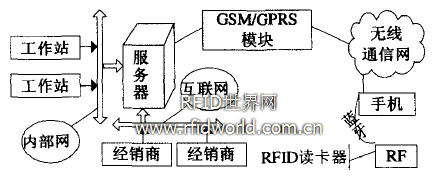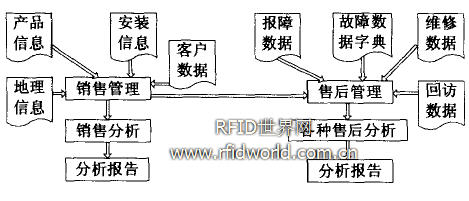Design of after-sales service management system based on RFID and smart phone
0 Preface
This article refers to the address: http://
Although the development of technology makes the quality of products higher and higher. However, there is no good policy to be foolproof, and problems caused by improper use of the customer and the use environment may occur. More and more companies (even the best companies) cannot guarantee that no mistakes will occur and customer complaints will be caused. Therefore, effective handling of customer complaints, timely remediation of mistakes and other perfect after-sales service measures has become the most effective way to protect consumer rights, and it is also a magic weapon for enterprises to compete in the increasingly fierce market competition. Introduce advanced technology. Utilizing a unified information management platform to optimize existing business processes and improve work efficiency has become an important means to improve after-sales service.
1 design plan
1.1 System Architecture
The system consists of components, sales workflow, after-sales maintenance workflow, etc.

Figure 1 system composition
In Figure 1. The system is connected to the server through the intranet of the enterprise computer, and the system client program runs on the workstation. The database and GSM/GPRS service program run on the server, each dealer system connects to the server through the Internet for data upload and download, and the on-site work user (installation, maintenance, etc.) uses GSM/GPRS and server through the system running on the smart phone. connection. The smartphone uses Bluetooth to connect to the RFID reader to work.
The sales workflow is shown in Figure 2. In Figure 2. Sales management process. The product needs to be scanned for electronic tags. Registered products leaving the factory: at the dealer. The dealer can connect to the Internet to register the arrival of the product: after the product is sold, submit the installation order. The dealer dispatches the workers, and the installer scans the product RFID with the mobile phone and the card reader after installing on site. Enter the relevant installation and customer information transfer to submit to the headquarters server. After receiving the information submitted by the installer (automatically formed in the system), the customer service personnel should conduct a customer return visit (telephone) and register the return visit. At this point, the sale is complete.

Figure 2 Sales workflow
The after-sales maintenance work flow is shown in Figure 3 in Figure 3. The after-sales maintenance begins with the customer's report. Receiving a report can be a headquarters or a dealer. After receiving the report, Quickly form a report, develop a maintenance plan, and then send a work order. Let the dealer send personnel to the site for maintenance work. After the maintenance engineer arrived at the scene. Scan the product RFID number with your mobile phone and card reader. Send to the headquarters server, download the warranty, maintenance record, model specifications and other related information of the product. You can also find related faults and solutions on your system on your smartphone. After the repair is completed, submit the repair situation to the headquarters. After receiving the maintenance report, the customer service staff of the department will conduct a return visit (telephone) in a timely manner to confirm the maintenance situation and collect customer opinions and satisfaction with the service. At this point, the repair service process is over.

Figure 3 After-sales maintenance workflow
The simple data flow of the system is shown in Figure 4.

Figure 4 system simple data flow
2 Technology used by the system
2.1 RFID and smart phones, wireless communication technology
Compared with other after-sales management and tracking systems on the market, this system combines RFID with smart phones and wireless communication technologies to enable sales tracking, on-site installation, on-site maintenance, etc., and can be quickly and conveniently used in the field using smart phones and wireless communication networks. Get and submit information about the product at a time, so that the enterprise manager can get the camera after-sales information of the product faster and more accurately. Convenient production decision: First-line installation and maintenance engineers for on-site work. They can also quickly and accurately obtain the production information, maintenance records, maintenance dates, etc. of the product, which is convenient for work and improves work efficiency.
The smart phone selected in this solution is a smart phone using Microsoft WindowsM0bile 5.0 operating system. Microsoft's Windows M0bile 5.0 makes it easy for developers to take advantage of the power of modern mobile devices
2.2 Introduction of GIS. Making data information in MIS and GIS geography
Close integration of information
Introduce the GIS fGeographic Information System (GIS) function to realize the geographical distribution of various thematic maps, including: thematic maps of sales, maintenance, defects, etc. GIS graphics management part of the function includes the basic operational functions of GIS such as map zooming, zooming out, roaming and query positioning. The system uses Mapinfo's MAPX development.
2.3 Using Workflow Technology
Using workflow technology, employees can always know what they need to do, managers can understand the specific implementation of each job, do post-evaluation supervision, work plan is implemented.
2,4 Developed with modular technology, open data interface adopts modular technology development, open data interface, convenient for customized modification, and can add more management modules according to customers' actual needs, such as after-sales service, procurement, Modules such as inventory and sales are integrated to truly enable customers to achieve the highest level of software satisfaction.
3 system function design
The system function is divided into three parts: server, workstation and smartphone.
3.1 Server section
(1) GSM/GPRS service management
This part of the service program is used to communicate with the smartphone to receive and send information. Receive the information sent by the smartphone, update the database, and perform parameter setting management on the GSM/GPRS module. It mainly includes a receiving module, a sending module, and a setting module. Receive module: The main function is to monitor the SMS in the GPRS module. Receive and analyze the content of short messages, respond to various types of messages (including information, commands, reports, etc.), call related handlers for database updates, or directly reply: Send module: The main function is to respond to related client programs. Request, generate, analyze, and send out information. Setting module: The main function is to set the GSM/GPRS module. For example, the short message service center, the local number, the identification ID, the server password, etc., in short, are necessary parameters to enable the service program to work normally.
3.2 background program part
Including basic data management, sales management, after-sales service management, after-sales analysis, etc.
Basic data management: mainly to maintain the basic data and data dictionary of the system. Provides the most basic support for the normal operation of the system. Main management functions include personnel/smartphone management, dealer management, fault type management, solution management, product warranty file management, customer file management, map management, system setting;
Sales Management: Provides services related to product sales, including sales and installation, product tracking, etc. The main management functions include product library management, sales tracking, sales analysis, installation task list, installation tracking, reminder, installation return visit management, and installation return visit management.
After-sales service management: The main management functions include report management, scheduling, maintenance task list, maintenance tracking reminder, and maintenance return visit management.
After-sales analysis: main management functions are fault condition analysis, customer satisfaction analysis, service delay analysis, and agency personnel benefit analysis.
3.3 Smartphone section
(1) Installation management
(2) Maintenance management
4 Conclusion
RFID has been widely used in foreign countries, and the country is now vigorously promoting the application of RFID. It is believed that the technology of this solution can be widely applied in the near future. However, in the current domestic situation, due to the popularity of RFID and cost issues. At present, the system is more suitable for the production of larger products or more expensive products (such as various home appliances, computer equipment, electrical equipment and other special equipment).
LED Strip Lights,LED Strip Lamp,Waterproof LED Strip
LED Bulb Light Bracket Co., Ltd. , http://www.challleds.com